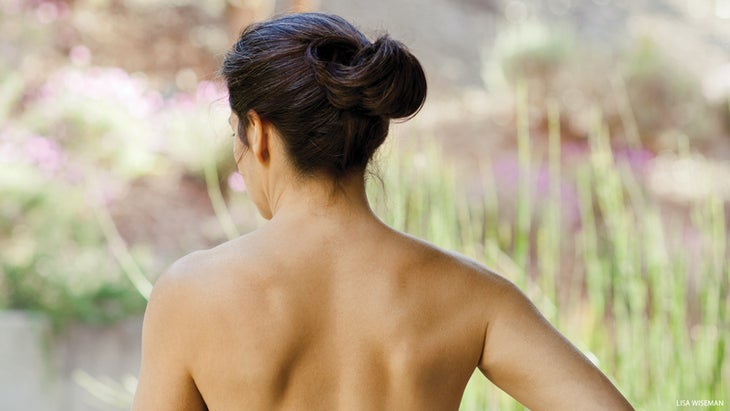Heading out the door? Read this article on the new Outside+ app available now on iOS devices for members! Download the app.

At the beginning of my second session of myofascial release—a type of bodywork that involves coaxing connective tissues to open—I got to talking with the physical therapist, Rachel Berger of Brookline, Massachusetts, as she worked on me. When we finally quieted down 20 minutes later, I did what I’d done during my first visit: I closed my eyes and tuned in to my body and breath. As Rachel lifted my neck, I focused on the sensations and used slow, deep breathing to help release my muscles.
Later, she told me that until we had stopped talking, my body hadn’t been responding as in the first visit, when we both were quiet and which we thought had been a big success. In that first session, I felt like I had been facilitating her subtle work by bringing yogic awareness to the treatment table. It turned out my intuition had been correct.
In fact, I’d wound up in Rachel’s office due to the awakening of intuition and awareness of my body that I link to yoga. In a recent practice session, I’d become aware of what yogis would call an “energetic blockage” in the area connecting my right upper neck to the back of my head. My sense was that my inability to create anatomical space and alignment there was rippling downstream through my right chest and abdomen, all the way down to my right calf. My intuition told me that a good bodyworker might be able to help the area open. A few calls to some friends yielded Rachel’s number, and I set up an appointment.
Many physicians and scientists say there is no science behind healing practices like myofascial release and craniosacral therapy, another modality that Rachel employs. And they are right: There are virtually no studies that prove their effectiveness. But that does not mean these therapies are necessarily ineffective.
As with yoga itself, the real proof of bodywork is in the direct experience. And the more yoga you do—especially if you complement it with various forms of bodywork—the deeper your ability to sense your inner experience becomes. Yoga practitioners frequently discover that they develop finer and finer perception in areas of the body where they previously felt little. B.K.S. Iyengar calls this phenomenon awakening intelligence in the body.
With that in mind, here are some suggestions for using the wisdom of yoga to get the most out of bodywork.
Cultivate silence. Taking some time for information exchange and explanation is fine. Just don’t spend half your session as I did, chatting as you might with someone cutting your hair. Your awareness—and that of the practitioner working on you—can be more profound when you are both quiet. In some situations, music can facilitate relaxation, but if it in any way distracts you from internal sensations, it’s best to forgo it.
Be mindful of sensation. If you find yourself going over your day, resentments, or fantasies for some future happiness, try to return to the present. Tune in as finely as you can to the effect of every stroke of the practitioner’s hands. Examine how what’s happening in your body is reflected in your breath, your sense of warmth, and other bodily sensations. Notice any unnecessary tightening: Check for tension in your jaw, your tongue, the space between your eyes; especially pay close attention to any areas of the back or neck where you chronically get tight.
Find the connections. In yoga practice, we learn to sense the ways that different parts of the body influence one another. In standing poses, for instance, creating space between the toes helps us open through the legs and into the hips. In Savasana (Corpse Pose), letting go of the jaw facilitates release of tension in the tongue and throat. During a bodywork session, can you notice whether your chest relaxes a notch as the practitioner works on your neck? Or can you find a perhaps more unexpected connection, like sensation in your right hip when your left shoulder is being massaged?
Use your breath.Your breath can do more than help keep you in the present moment; it can also help get you through some of the moments when bodywork becomes especially physically intense. I’m not sure that I could have tolerated some Rolfing and neuromuscular therapy sessions I’ve had without using deep Ujjayi breathing.
Take what you find back to your yoga practice. If you’ve paid attention during your bodywork sessions, you may have found opening or awareness in areas where you didn’t have it before. During your next yoga practice, see if you can find that opennness again and perhaps go even deeper.
Don’t sweat the theories. Some people shy away from certain types of bodywork because they doubt the explanations practitioners give for how those modalities work. Articles in medical journals, for example, ridicule the contention of craniosacral therapists that they adjust the skull bones, insisting this is impossible since these bones are fused early in life. But how something works is not as important as whether it works. And my experience suggests that many forms of bodywork (including craniosacral therapy) can be very effective.
Stay open-minded. If you are interested in exploring bodywork, be open to trying multiple styles. Be guided by word of mouth, particularly from people whose yoga practice or other experience has given them good body awareness. It would be great if there were more scientific evidence of effectiveness, but most bodywork methods have never been formally studied. There is also something ineffable that talented bodyworkers of all persuasions do that can’t be captured in study results. If you wait for the kind of proof most doctors look for, you won’t be able to take advantage of most bodywork styles in this lifetime.
Timothy McCall is a board-certified specialist in internal medicine and Yoga Journal‘s medical editor.